Russia holds a wealth of sightseeing opportunities across all nine of its time zones, incorporating the largest forestland and freshwater supply in the world. It's little wonder that Russians refer to their country as the Motherland - it is, undeniably, a bountiful place. Seeing Russia in all her glory would be a mighty, and time-consuming, feat.In St Petersburg, the State Hermitage Museum captures ancient to modern Russian history in the six buildings which make up the Winter Palace - the former residence of the tsars. The Moscow Kremlin is a wonder to behold; alongside it is Red Square, Moscow's broad and bustling city square flanked by the famous Basil Cathedral. The Bolshoi Ballet Theatre, in neighbouring Theatre Square, is one of the most ornate theatres in the world and is home to the world's oldest and most successful ballet company.There is, however, more to see by way of both history and natural splendour. Russia is jokingly referred to as the 'lungs of Europe' due to the expansive forestland, which is said to absorb about 15 percent of the world's carbon dioxide. As you progress east, the forest becomes more dense and overwhelming. The best way to take in the Russian countryside is by train, as the Trans-Siberian Railway winds southeast from Moscow on the same route that once transported prisoners of Stalin's purges to gulaglabour camps. Those in search of natural beauty should also consider travelling down to Lake Baikal, the deepest and largest lake (by volume) in the world and a UNESCO World Heritage Site.
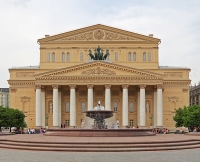
Moscow's oldest and most famous theatre, the Bolshoi, dates from 1824 and is home to world-renowned opera and ballet companies. Completely rebuilt after a fire in 1856, the grand building is a masterpiece of Russian neoclassicism, including an eight-columned entrance porch topped by the horse-drawn chariot of Apollo, patron of the arts. The glittering five-tiered interior is richly adorned with red velvet furnishings, ornate gold detailing and chandeliers, and the size of the auditorium makes it one of the largest theatres in the world. The Bolshoi Theatre has hosted some of the world's most celebrated premieres, including Swan Lake, Spartacus, and concerts by Richard Wagner. Attending an evening performance at the Bolshoi Opera and Ballet Theatre constitutes one of Moscow's best nights out.
Address : Theatre Square, 1, Moskva, Russia.
E-mail : [email protected]
Website : www.bolshoi.ru/en
Telephone : +7 495 455 5555
Transport : Metro stop Teatralnaya.
Opening times : 11am-8pm
Admission : Ticket prices for performances vary.
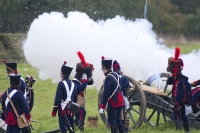
The battle of Borodino is regarded as the bloodiest of the Napoleonic battles, seeing over 70,000 casualties in a single day and leading Napoleon to brand the Russians as 'invincible'. The Borodino Panorama Museum was inaugurated in 1960 and serves as an exhibit of artefacts and displays from the Napoleonic wars, with a collection of wartime memorabilia on one level and the enormous panorama on another. The panorama referred to in the name is, incidentally, not an outdoor view but a 360º painting by Franz Roubaud depicting a crucial moment in the battle itself. The mural is 115 meters long and 15 meters high. The museum will delight military history buffs, but should also impress the uninitiated. Those with smartphones can download the museum's interesting audio guide, helped along by free wifi.
Address : Kutuzovsky Prospect, 38, bld. 1, Moscow, Russia.
Website : www.1812panorama.ru/english.html
Telephone : +7 499 148 1967
Transport : The Museum can be walked to from Metros Park Pobedy and Kutuzovskaya, respectively.
Opening times : Saturday to Wednesday: 10am-6pm. Thursday: 10am-9pm. Closed on Fridays.
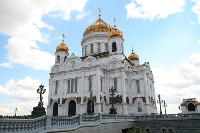
After Napoleon retreated from Russia, Tsar Alexander I declared that a cathedral be built in remembrance of the soldiers who had died defending Mother Russia. The original cathedral took more than 40 years to build. Decades later the cathedral was demolished by Stalin (who found the monument abhorrent) to make way for the colossal Palace of the Soviets, intended to be a symbol of Russian Communism, which was never actually built. The Cathedral of Christ the Saviour was rebuilt again, on the same site, between 1990 and 2000 as a faithful duplicate of the original. It is currently one of the largest and tallest Orthodox Churches in the world. The contemporary Russian artwork, statues and memorials to the Russian Tsars, as well as a small indoor museum, are well worth a look.
Address : Ulitsa Volkhonka, 15, Moskva, Russia.
Website : www.xxc.ru/
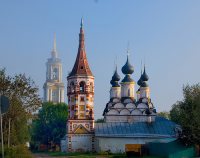
Consisting of a circuit of historic cities northeast of Moscow, the Golden Ring is a popular tourist route for travellers in Russia. The cities are popular for their distinctive architecture (recognizable for the uniquely-Russian onion-shaped domes and colourful ornamentation), and their tradition of handmade craftsmanship, offering tourists a good opportunity to buy beautiful Russian souvenirs. The official list of towns in the Golden Ring includes Ivanovo, Kostroma, Pereslavl-Zalessky, Rostov Veliky, Sergiev Posad, Suzdal, Vladimir, and Yaroslavl. They are all spaced close enough to each other (and to Moscow and St Petersburg) to reach on horseback within 24 hours, making them ideal for a driving tour. The cities are fairly similar, so it is not necessary to visit them all, and most travellers choose to see only four or five. One city that should not be missed, however, is Sergiev Posad, the centre of the Russian Orthodox Church and home to the impressive Sergiev Posad Monastery. Suzdal is another highlight on any Golden Ring tour, home of the St.Euthymius Monastery and the enormous Spaso-Evfimiev Monastery, which houses 10 museums and is nearly as impressive as St Basil's in Moscow.
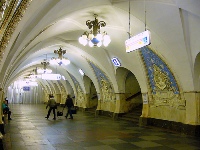
Taken together, Moscow's Metro stations amount to the most beautiful public transport facility in the world. Visitors to Moscow should not miss taking a ride on this glorious underground rail system, and exploring the stations. Each one has its own, distinct aesthetic, variously adorned with Realist artworks, chandeliers, ornate pillars and marble floors. Moscow's Metro caters to something like two and half billion passenger rides per year, making it one of the busiest underground metro systems in the world. Despite this, the stations are more akin to palaces or five-star hotel lobbies rather than functional spaces. The depth of the elevators is also astounding. Most travellers will encounter the Metro system for practical reasons, but many will find that they choose to spend more time than necessary underground! There are nearly 200 stations but some of the most beautiful and ornate are Kiyevskaya, Dostoyevskaya, Prospekt Mira, Mayakovskaya and Ploshchad Revolyutsii.
Address : The Moscow Metro covers most of the city.
Website : engl.mosmetro.ru
Opening times : Daily 5:30am to 1am.
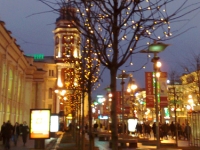
Almost three miles (5km) long, Nevsky Prospekt is one of the best-known streets in Russia and is the main thoroughfare of St Petersburg. The Nevsky Prospekt starts at the Admiralty building whose gilded spire is a famous city landmark, passes the Moscow Railway Station and the Alexandr Nevsky Monastery, where some of the country's most celebrated artists are buried. Nevsky Prospekt has been the hub of St Petersburg for centuries and cuts through the most important segment of the city. Intersected by rivers and canals, the most beautiful part of the avenue surrounds the Griboyedov Canal. Here the impressive colonnade of the grand Kazan Cathedral catches the eye, curving around a small grassy square opposite the breathtaking, multi-coloured onion domes of the 'Church of Our Saviour on the Spilled Blood' - which is officially called the Resurrection of Christ Church. Modelled on St Basil's Cathedral in Moscow and adorned with exquisite mosaic panels, the church is one of St Petersburg's most striking landmarks. It was built on the site of the assassination of Emperor Alexander II in 1881.As well as many churches, the street boasts St Petersburg's finest shops and restaurants, old manors and impressive buildings, and a beautiful mixture of architectural styles from the different periods of its history. If you walk down only one road in St Petersburg make it the Nevsky Prospekt.
Website : www.nevsky-prospekt.com
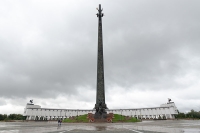
Poklonnaya Hill means 'bow hill', and lies in the west part of Moscow. Historically, is was a spot for Western visitors to pay homage to the city before entering. Today it is a beacon to Russia's military strength, having withstood invasions by both Napoleon and Hitler. Atop the hill is Victory Park which provides a scenic walk and contains a memorial Mosque and Synagogue for victims of the war, and an open air museum dedicated to the victory over Napoleon. There are many tanks and other wartime vehicles on display in Victory Park, along with several impressive monuments and statues. History buffs will love exploring the many attractions of Poklonnaya Hill and Victory Park, and even those not interested in military history will enjoy the art and the views.
Address : Moscow, Russia.
E-mail : [email protected]
Website : www.poklonnaya-gora.ru/en
Telephone : +7 499 148 8300
Transport : Disembark from the Metro at Park Pobedy.
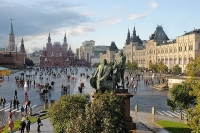
Red Square is a dramatic cobbled square in the centre of Moscow. Originally the city's marketplace, the square also served as a public gathering place to celebrate festivals, listen to government announcements or witness executions, especially common during the reign of Ivan the Terrible. The Soviet state turned it into a memorial cemetery, and constructed Lenin's Mausoleum to one side - a crystal casket containing the preserved body of the founder of the Soviet Union that is still open for public viewing today. The communist government destroyed several ancient buildings around Red Square, including the Resurrection Gate and chapel, to make space for and to allow easy tank access to the demonstrations and military parades that were often held in the area. The current Resurrection Gate and chapel are replicas that were built in the 1990s. Red Square's most impressive military parade involved the gathering of thousands of Russian soldiers ready to march to war against the Nazis in 1941; it was also the site of many parades during the Cold War.The word 'red' doesn't apply to the colour of the brickwork, neither is it a reference to communism. The meaning of the word 'krasny' originally meant 'beautiful' in Old Russian, referring to St Basil's Cathedral at the southern end, but over the centuries the word changed to mean 'red' too, thus the square's present name. St Basil's Cathedral is the city's most well-known building and is crowned by the bulbous multi-coloured domes for which it is so famous.
Address : Red Square, Moscow, Russia.
Transport : Metro stop Ploshchad Revolutsii.
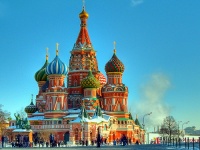
St Basil's Cathedral stands on the edge of Moscow's Red Square, and is the most famous landmark in Russia. Its striking design was commissioned by Ivan the Terrible to commemorate his victorious military campaign against the Tartar Mongols at Kazan in 1552. Legend has it that Ivan was so overwhelmed by its beauty that he had the architect blinded to prevent him from creating anything to rival it. St Basil's Cathedral includes a central chapel surrounded by eight tower-like chapels, each crowned with a different coloured and uniquely patterned onion-shaped dome. The church escaped demolition many times during the city's turbulent history and with the beginning of the Soviet regime the cathedral was closed and later turned into a museum. The interior is a dimly lit maze of corridors and delicately decorated chapels. One of them houses a priceless, icon-decorated 16th century screen that shields the inner sanctuary. In comparison to the exquisite exterior, the interior can seem disappointing, but there is no question St Basil's is worth exploring.
Address : Red Square, Moscow, Russia.
Telephone : +7 495 698 3304
Transport : Metro stop Kitai Gorod.
Opening times : The museum is open 11am to 5pm in winter, and 10am to 7pm in summer.
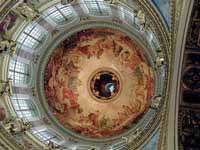
The golden dome of St Isaac's Cathedral dominates the skyline of St Petersburg, with the colonnade around the cupola offering superb panoramic views over the city. It was commissioned by Tsar Alexander I to be a magnificent imperial cathedral, and the ensuing masterpiece was of grandiose proportions, taking more than 40 years to build. It was decorated in the most extravagant manner. The Russian Classic exterior encloses a splendid interior adorned with red granite columns, exquisite mosaics, painted ceilings, sculptures, frescoes, and a beautiful stained-glass window, incorporating many different kinds of stone and marble work into the massive structure. The cathedral can accommodate 14,000 worshippers, but today services are held here only on special occasions. It is worth noting that no photography or filming is allowed in either the Cathedral or the Colonnade.
Address : St Isaacs Square, 4, St Petersburg, Russia.
E-mail : [email protected]
Website : eng.cathedral.ru
Telephone : +7 812 315 9732
Transport : Take a metro trip to Admiralteyskaya station.
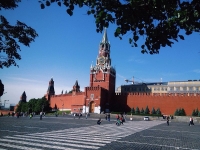
The Kremlin is a fortress surrounded by a thick red wall interspersed with 20 towers that was built between 1482 and 1495. The complex consists of a number of glittering, golden-domed churches and palaces, museums, residences, offices, assembly halls and monuments. It was home to the royal regime during Tsarist rule and the seat of the Communist government from 1918 onward. Cathedral Square is the religious centre of Moscow and the historic heart of the Kremlin. The attractive Annunciation Cathedral was set aside for the private use of royalty and contains beautifully painted murals and icons on the interior walls. The throne of Ivan the Terrible can be found in the Cathedral of the Assumption, which was used for the coronation of tsars; most of the leaders of the Russian Orthodox Church are buried here and their tombs line the walls of the spacious, richly coloured interior.The Belfry of Ivan the Great is the tallest structure within the walls and a visible city landmark. At its foot lies one of the world's biggest bells, broken in a fall from its bell tower in 1701, and nearby is one of the world's largest cannons, the Tsar Cannon. Also within the Kremlin is the Armoury Palace. It is the richest and oldest museum and houses a staggering collection of treasures gathered over the years by the church and Russian state. These include jewel-studded coronation capes, thrones encrusted with diamonds, royal coaches and sleighs and the renowned jewelled Fabergé Easter eggs, each containing an exquisitely detailed miniature object of precious metal inside. The Diamond Fund Exhibition in the same building contains the 180-carat diamond given to Catherine the Great by Count Orlov.
Website : www.kreml.ru/en
Transport : Metro stop Biblioteka imeni Lenina or Aleksandrovsky Sad.
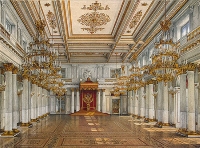
The magnificent green, white and gold Winter Palace is superbly situated on the banks of the Neva River. At 656 foot-long (200m), the Russian Baroque building is the biggest and most lavishly decorated palace in the city. It was the official residence of the tsars, and Catherine the Great later added the Small and Large Hermitages onto the palace as a sanctuary for herself and her private art collection. The Hermitage Museum comprises a stately complex of buildings strung along the embankment, with the Winter Palace at its heart. The Hermitage Museum is one of the world's greatest art museums, with a collection that has grown from the paintings of Catherine the Great in 1764 to a collection of more than three million pieces. This vast collection is housed within the sumptuous splendour of one of the most luxurious palaces in the world. The three floors cover a full range of world art from ancient times, to Russian works and 20th-century European examples, as well as a fabulous collection of Impressionist and Post-Impressionist paintings, set against the rich interior of white marble staircases, golden ceilings, crystal chandeliers, and elaborate mosaics.
Address : Palace Embankment, 32, Sankt-Peterburg, Russia.
E-mail : [email protected]
Website : www.hermitagemuseum.org
Telephone : +7 812 710 9079
Transport : Take the metro to Admiralteyskaya Station.
Opening times : Wednesday, Friday: 10.30am to 9pm. Tuesday, Thursday, Saturday, Sunday: 10.30am to 6pm.
Admission : Full access ticket: RUB 700.
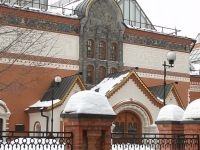
The Tretyakov Gallery houses some of the great masterpieces of traditional Russian art from before the Revolution and has the world's finest collection of Russian icons from the 11th to the 17th-centuries. The gallery's collection of paintings, graphics and sculptures covers Russian art from the 18th to the 20th century. The gallery was named after its founder, Pavel Tretyakov, an art collector who donated about 2,000 works of art from his private collection to the city of Moscow, forming the basis of the collection to which state acquisitions were later added. He also donated his own house, which became the original site of the art gallery. Two separate buildings at different locations house the works selected for display.
Address : Lavrushinsky Ln, 10, Moscow, Russia.
E-mail : [email protected]
Website : www.tretyakovgallery.ru/en
Telephone : +7 495 957 07 01
Transport : Take to metro to the Tretyakovskaya metro stop, and walk for 317 yards (290m).
Opening times : Tuesday, Wednesday, and Sunday: 10am to 6pm. Thursday, Friday, Saturday: 10am to 9pm.
Admission : Adults: RUB 500. Minors enter for free.

Travel Guide powered by Word Travels, copyright © 2023 Globe Media Ltd. By its very nature information in this travel guide is subject to change at short notice and travellers are urged to verify information on which they're relying with the relevant authorities. Neither Globe Media Ltd nor Travel Vogue can accept any responsibility for any loss or inconvenience to any person as a result of information contained above.